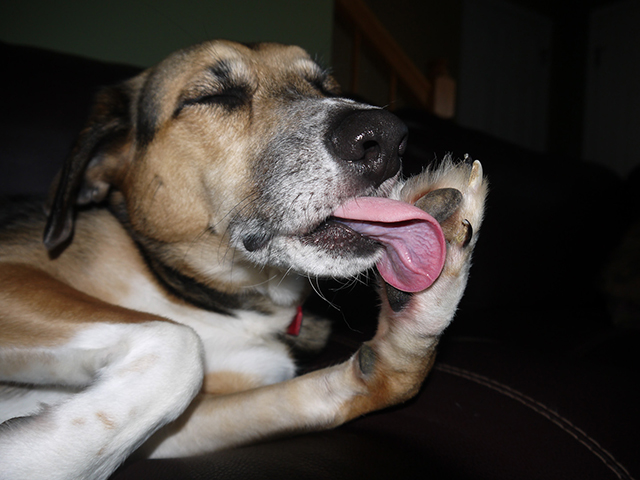By: Dr. Peter Dobias, DVM, IVC Journal, Integrative Medicine
For any practicing veterinarian, paw licking and chewing is a very common complaint and often, even with holistic approaches can be difficult to treat. Conventionally, this is considered an allergic response.
Most dogs are taken through a battery of tests, put on hypoallergenic and elimination diets, and repeated and long term antibiotics. Many end up on corticosteroids. Unfortunately, many of these dogs continue licking.
For years, I cringed every time I saw a dog that excessively licked his paws. I agree that allergies should be on the differential diagnosis list. However, we all know that many affected dogs improve only marginally when they are treated for allergies.
For the longest time, I tried different diets, homeopathy, herbal supplements and detox protocols, but the results were not as good as I hoped for. I asked myself if I was missing something important and started looking at these patients with fresh eyes.
LOOKING FOR NEUROLOGICAL
Then it dawned on me. Could it be that “paw lickers” paid attention to their feet because of an abnormal neurologic sensation or referred pain originating from the neck? I started to look closer at the patterns I was seeing, and began examining the neck and spine for discomfort, muscle spasm, inflammation and tightness.
Surprisingly, most of the patients that licked their front feet had signs of lower cervical inflammation and discomfort. The dogs that licked their forearms had muscle spasms and inflammation in the inter-scapular region. Those that were licking their hind feet often had signs of injury in the lumbar spine – the origin of nerves supplying the hind feet.
I also noticed that front paw lickers often pulled on the leash or their guardians used a collar attached to a retractable leash. The dogs with hind foot licking were often sprinters and ball retrievers, and frequently had signs of para-spinal muscle injuries and strain of the lumbar spine.
This made sense from an anatomical and neurological point of view. Nerve and energy meridian pathways are affected or “impinged” by tight muscles, collars or leash jerks.
Looking at the position of the collar itself, it is logical that it could cause neck and nerve injury in a dog that is prone to pulling. When it comes to dogs on retractable leashes, the spring of the leash develops a continuous pull that generates a degree of stress in the cervical region. In addition, when a dog gets to the end of the retractable leash, the sudden stop and jerk causes additional force.
Based on this observation, I started addressing the injuries and tightness I was observing. To my surprise, a large majority of these dogs recovered completely or improved significantly, depending on the severity of the injury and the chronicity of the condition.
ADDRESSING ROOT CA– USES THAT TRIGGER PAW LICKING
If you are interested in trying this approach, here is what I suggest. I assume your patient has already been examined, that blood work has been done, and he is being fed a wholesome natural diet and essential vitamins, minerals and Omega oils.
1. Ask the client to use a front clip harness such as Walk In Sync or similar to reduce stress on the cervical spine.
2. Never attach the leash to a collar, especially when a dog pulls frequently.
3. If your patient licks his hind feet, ask the client to prevent him from sprinting, jumping, leaping in the water, or retrieving balls for at least a month. This will reduce the muscle tightness that usually affects nerve and energy pathways to the hind feet.
4. Chiropractic, physiotherapy or osteopathic adjustment or therapy is an essential part of the treatment.
5. Ask your client not to play tug-of-war with the dog, or if they do, to let the rope or leash gently slide through their hands. Instruct them not to lift the dog in the air when tugging.
6. Encourage the client to feed a species appropriate diet and supplement the dog’s food with whole food-based supplements. I use SoulFood (organic multivitamin), GreenMin (plant-based mineral support), and WholeMega salmon oil.
7. If you suspect your patient’s liver has been stressed and needs to detox, consider Livton by Standard Process.
8. I also suggest Zyflamend, an all-natural turmeric-based anti-inflammatory. I have used it for more than four years in dogs, with great results, and have seen no evidence of side effects.
Using this treatment protocol, changes should be evident within one to eight weeks, depending on the severity of the case.










